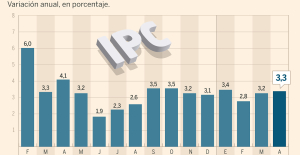“I was very lucky,” Lionel Ribes thanks his mother who was trying to understand the cause of her own high cholesterol. Consultation with Professor Jean-Luc de Gennes of Pitié-Salpêtrière in Paris: when the doctor sees her, he immediately asks to see her children. Lionel is soon to be an adult, he is sporty and in good health, but his blood tests reveal, as he tells us, a “huge” cholesterol level.
Familial hypercholesterolemia (FH) is diagnosed and treatment begins. Now aged around fifty, Lionel Ribes is president of the National Association of Familial Hypercholesterolemia and Lipoprotein (a) (Anhet.f). He says he is lucky, because in France, the vast majority of patients are not diagnosed, which puts them at serious risk. In fact, this silent disease does not present any particular symptoms until the first: a heart attack. With his association, he campaigns for a universal diagnosis.
Also read: Cholesterol at 10: why does familial hypercholesterolemia, the most common genetic disease, remain invisible?
Noël Peretti, pediatrician and professor of nutrition, head of the gastroenterology and hepatology department at Lyon University Hospital, supports this claim and describes this genetic disease which prevents cholesterol from entering the liver cells, which have the function of eliminate it, thus causing its accumulation in the blood and on the walls of the arteries. This phenomenon causes fatty deposits (atheromatous plaques) which lead to reduced blood flow. Without knowing the precise reason, it is the heart arteries which are particularly affected, resulting, in the absence of treatment, in a high risk of heart attack.
Two forms of the disease exist – homozygous or heterozygous – depending on whether both versions of the gene are affected or not. The first is very serious, which can lead to sudden early death in childhood if it is not treated. Fortunately, it is rare (one person affected in 250,000 in France). The heterozygous form is much more common, 1 in 300 people in our country. The latter, if diagnosed young, is treatable. By taking medication, it is possible to maintain a correct cholesterol level, avoid its accumulation on the walls of the arteries and prevent heart attacks which often occur in young adults.
On November 28, the Anhet.f association published a white paper to warn about the lack of diagnosis and to propose early universal screening for familial hypercholesterolemia, which would be “the only solution to save thousands of lives.” This publication highlights the work of health economist Gérard de Pouvourville, who estimates that screening at an early age would save an average of eight years of life for each child screened. The diagnosis could be established relatively easily via a lipid assay based on a blood test taken as part of one of the obligatory medical visits in the child's care pathway.
Also read: Cholesterol: should we be wary of statins?
The association wishes to go further than the recommendations of the High Authority of Health which until now recommends screening only the members of a family from a patient, diagnosed by chance, most often after a first accident cardiovascular. The white paper is now on the desk of the Minister of Health. It is up to him and Parliament to take up the matter.

 B:SM will break its investment record this year with 62 million euros
B:SM will break its investment record this year with 62 million euros War in Ukraine: when kyiv attacks Russia with inflatable balloons loaded with explosives
War in Ukraine: when kyiv attacks Russia with inflatable balloons loaded with explosives United States: divided on the question of presidential immunity, the Supreme Court offers respite to Trump
United States: divided on the question of presidential immunity, the Supreme Court offers respite to Trump Maurizio Molinari: “the Scurati affair, a European injury”
Maurizio Molinari: “the Scurati affair, a European injury” Inflation rises to 3.3% in April and core inflation moderates to 2.9%
Inflation rises to 3.3% in April and core inflation moderates to 2.9% Pedro Sánchez announces that he continues "with more strength" as president of the Government
Pedro Sánchez announces that he continues "with more strength" as president of the Government Irritable bowel syndrome: the effectiveness of low-carbohydrate diets is confirmed
Irritable bowel syndrome: the effectiveness of low-carbohydrate diets is confirmed Beware of the three main sources of poisoning in children
Beware of the three main sources of poisoning in children Relief at Bercy: Moody’s does not sanction France
Relief at Bercy: Moody’s does not sanction France More than 10 million holders, 100 billion euros: the Retirement Savings Plan is a hit
More than 10 million holders, 100 billion euros: the Retirement Savings Plan is a hit Paris 2024 Olympic Games: the extension of line 14 will open “at the end of June”, confirms Valérie Pécresse
Paris 2024 Olympic Games: the extension of line 14 will open “at the end of June”, confirms Valérie Pécresse Failing ventilators: Philips to pay $1.1 billion after complaints in the United States
Failing ventilators: Philips to pay $1.1 billion after complaints in the United States The Cannes Film Festival welcomes Omar Sy, Eva Green and Kore-Eda to its jury
The Cannes Film Festival welcomes Omar Sy, Eva Green and Kore-Eda to its jury Prisoner in Israel, a Palestinian receives the International Prize for Arab Fiction
Prisoner in Israel, a Palestinian receives the International Prize for Arab Fiction Harvey Weinstein, the former American producer hospitalized in New York
Harvey Weinstein, the former American producer hospitalized in New York New success for Zendaya, tops the North American box office with Challengers
New success for Zendaya, tops the North American box office with Challengers Skoda Kodiaq 2024: a 'beast' plug-in hybrid SUV
Skoda Kodiaq 2024: a 'beast' plug-in hybrid SUV Tesla launches a new Model Y with 600 km of autonomy at a "more accessible price"
Tesla launches a new Model Y with 600 km of autonomy at a "more accessible price" The 10 best-selling cars in March 2024 in Spain: sales fall due to Easter
The 10 best-selling cars in March 2024 in Spain: sales fall due to Easter A private jet company buys more than 100 flying cars
A private jet company buys more than 100 flying cars This is how housing prices have changed in Spain in the last decade
This is how housing prices have changed in Spain in the last decade The home mortgage firm drops 10% in January and interest soars to 3.46%
The home mortgage firm drops 10% in January and interest soars to 3.46% The jewel of the Rocío de Nagüeles urbanization: a dream villa in Marbella
The jewel of the Rocío de Nagüeles urbanization: a dream villa in Marbella Rental prices grow by 7.3% in February: where does it go up and where does it go down?
Rental prices grow by 7.3% in February: where does it go up and where does it go down? Europeans: a senior official on the National Rally list
Europeans: a senior official on the National Rally list Blockade of Sciences Po: the right denounces a “drift”, the government charges the rebels
Blockade of Sciences Po: the right denounces a “drift”, the government charges the rebels Even on a mission for NATO, the Charles-de-Gaulle remains under French control, Lecornu responds to Mélenchon
Even on a mission for NATO, the Charles-de-Gaulle remains under French control, Lecornu responds to Mélenchon “Deadly Europe”, “economic decline”, immigration… What to remember from Emmanuel Macron’s speech at the Sorbonne
“Deadly Europe”, “economic decline”, immigration… What to remember from Emmanuel Macron’s speech at the Sorbonne These French cities that will boycott the World Cup in Qatar
These French cities that will boycott the World Cup in Qatar NBA: young Thunder coach Mark Daigneault named coach of the year
NBA: young Thunder coach Mark Daigneault named coach of the year Athletics: Noah Lyles in legs in Bermuda
Athletics: Noah Lyles in legs in Bermuda Serie A: Dumfries celebrates Inter Milan title with humiliating sign towards Hernandez
Serie A: Dumfries celebrates Inter Milan title with humiliating sign towards Hernandez Tennis: no pity for Sorribes, Swiatek is in the quarterfinals in Madrid
Tennis: no pity for Sorribes, Swiatek is in the quarterfinals in Madrid

















